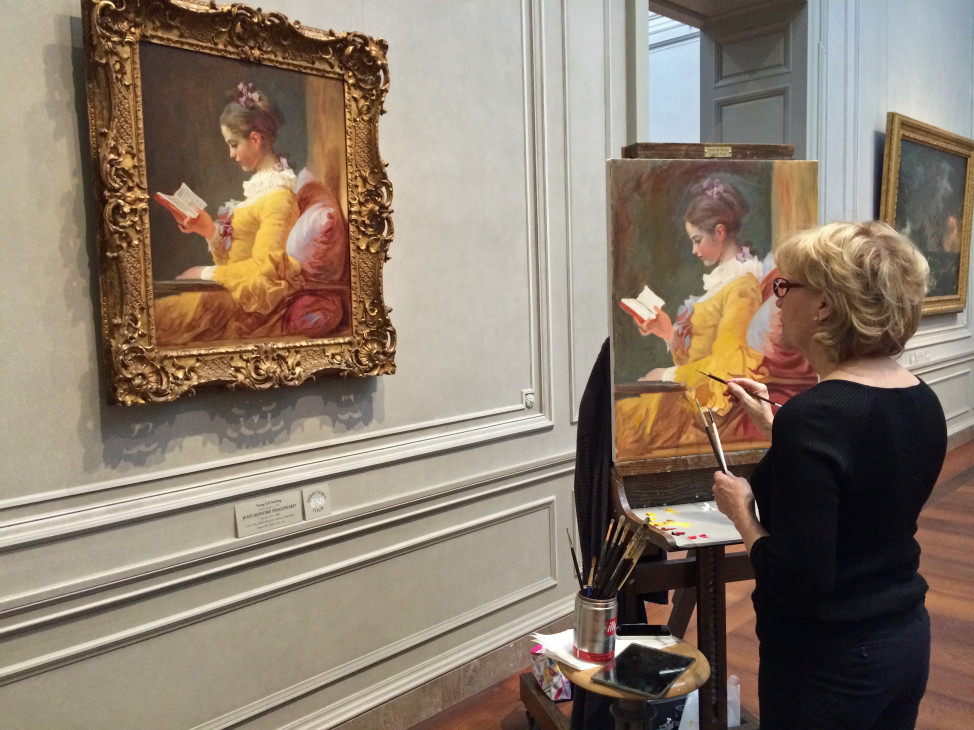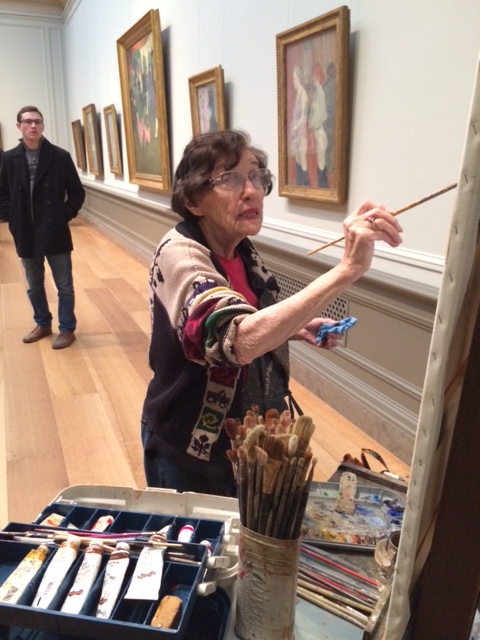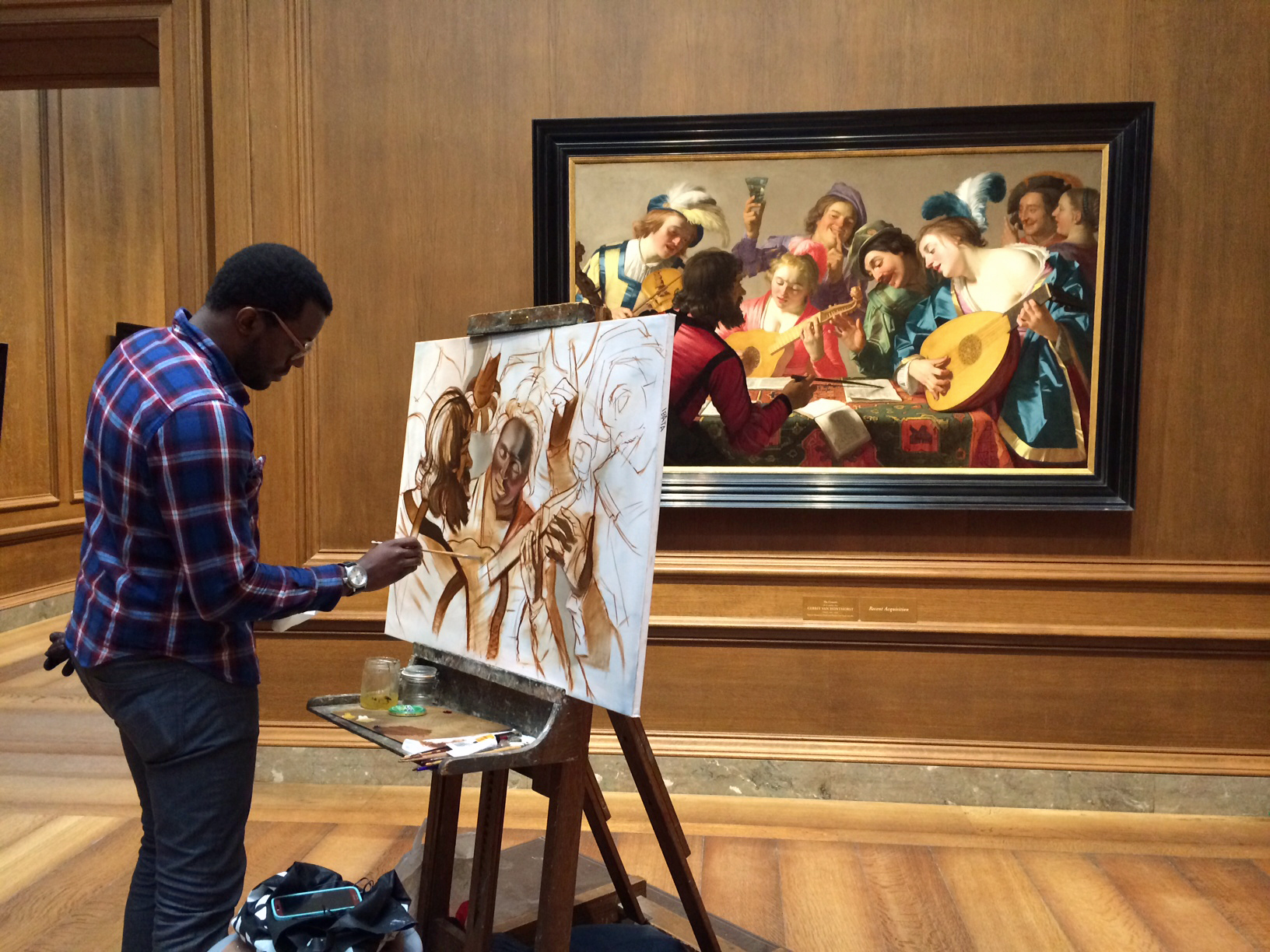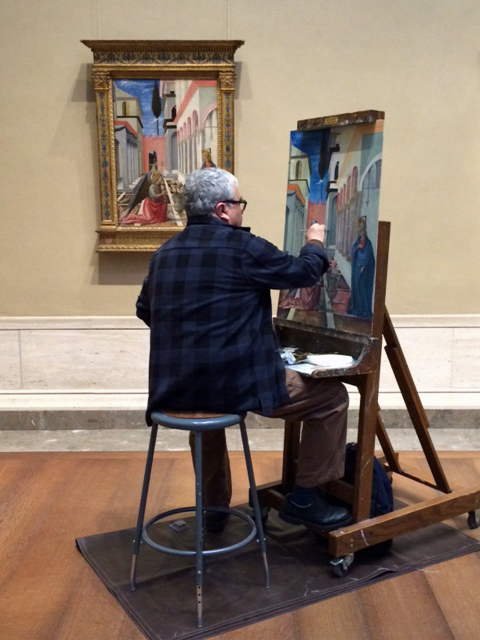
Pamela Jarrett, a full-time artist who has been painting for about 20 years, copies a painting at the National Gallery of Art in Washington, D.C.
On any day of the week at one of the nation’s premiere art galleries, you’ll find artists hard at work painting copies of masterpieces by renowned artists who lived centuries ago.
“It’s just so generous,” said copyist Pamela Jarrett, a full-time artist. “I lived in Italy for six years. It’s expensive, it’s prohibitive in the museums…There’s just a great generosity in the spirit of this particular museum.”
The copyist program is in keeping with the National Gallery of Art’s roots as a museum for the people.

Retired scientist Vivian Parker, 84, has participated in the copyist program for 10 years.
The gallery building and its works of art were a gift from American financier Andrew Mellon, an avid art collector who once served as the US secretary of the treasury.
One of Mellon’s stipulations was that the museum be free and open to the public.
“When Andrew Mellon established the National Gallery of Art, it was one of his mandates that this was art for the people,” said Sarah Holley, a publicist at the gallery. “It was a gift to the nation and you don’t charge for a gift.”
Copyists are also not charged for the privilege of spending time with the masters.
“I’ve been to the Louvre and I also have been a copyist at the Metropolitan Museum of Art in New York,” said Sonia Gadra. “This museum compares, I can say, to the best museums in the world. So being here is a wonderful privilege. I’m so excited to come every week.”
Not just anyone can become a copyist at the National Gallery of Art.
There is an application process. The gallery normally approves people who have at least some art education.
Copyists are generally permitted to paint at the gallery one day a week and some — like 84-year-old Vivian Parker — have been coming for years. Parker, who has a PhD in physical chemistry, worked as a scientist for 35 years before retiring and rediscovering her childhood love of painting.

Copyists have all levels of art training. David Ibata, an artist who teaches art classes, attended the Corcoran School of the Arts and the New York Academy of Art.
“Art was never considered a high priority for making a living,” Parker said. “Now I’m around masterpieces and I can copy them and enjoy them.”
A copyist’s canvas measurements are required to be different than the original paintings in order to avoid any potential accusations of forgery. While the artists bring their own paints and supplies, the gallery provides the easel.
Copyist David Ibata, an artist who teaches art classes, says there is a lot to learn from imitating the old masters.
“If I’m a writer, I want to go and read a novel and see the structure of the language. This is the same thing. I’m learning the language of the artist,” he said. “Creating better harmonies, a better sense of composition, better sense of learning how to paint the different textures and skin tones by just looking at these old techniques.”
Since the gallery opened in 1941, 240 million visitors — 4 to 5 million annually — have passed through its doors, and for many of them, the copyists are a bridge to the artistic past.
“You watch the lights come on in people,” said Jarrett. “You can walk around these rooms and look at the paintings..but when they actually see someone painting, they believe it. Somebody did it. Some human being had the skill to do this.”

Retired Texas minister Luis Orozco usually copies religious pieces of art which depict the Virgin Mary.
Some copyists, such as Luis Orozco, travel great distances to participate in the program. The retired Texas minister visits Washington, D.C. twice a year to paint at the gallery.
“Because I have previous studies in art, I could match both theology and the renaissance, the subject matter of the bible story,” he said. “They approach Mary as an icon of beauty and that became the thing that most fascinated me.”
Gallery visitors will run into copyists every day of the week. Only one copyist is allowed in a gallery room at a time, and there are six to nine copyists working in the gallery on any given day of the week, according to Carol Nesemann, who is in charge of the copyist program.
In drawing inspiration from masterpieces, the copyists are following in the path of some of history’s greatest artists.
Renowned painters Paul Cezanne and Pablo Picasso were once copyists who gained inspiration from the masters that eventually led to their own strokes of genius.






















It is SO good to read how the Gallery gives emerging artists a chance to learn from the Masters. What I like most about the program is that we, the public, get to observe these copyists at work, often with Masters we’ve never taken the time to consider before.
Well done, and thank you. Keep up the good work.
Elvira McIntosh (Australia)
“Art for the people” That’s sounds so good! Congratulations for the program.
Juan M. Orozco, México.
Thanks so much for showing my friend Luis Orozco’s work. He is my neighbor, and does beautiful work, in a most humble little setting.
Alan York, Happy Texas